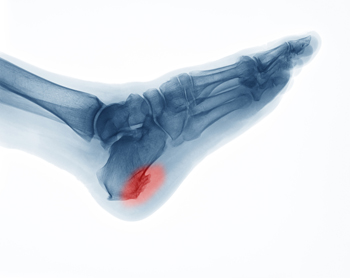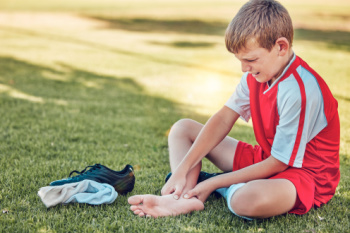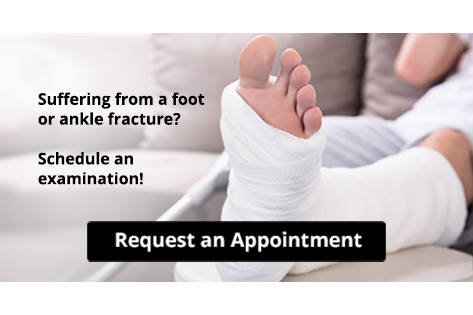Items filtered by date: March 2025
What Is a Heel Spur?

A heel spur is a bony growth that forms on the heel bone, typically at the point where the plantar fascia connects to the heel. It is often caused by repetitive strain or stress on the foot, which leads to inflammation in the surrounding tissues. Common causes include activities that involve excessive walking, running, or standing, especially on hard surfaces. People with flat feet or high arches are also more susceptible to developing heel spurs. Symptoms of a heel spur include sharp pain or discomfort at the bottom of the heel, particularly when standing up or walking after long periods of rest. The pain may decrease as the foot warms up but can return after prolonged activity. If you have heel pain, it is suggested that you consult a podiatrist who can accurately diagnose and treat what may be going on.
Heel spurs can be incredibly painful and sometimes may make you unable to participate in physical activities. To get medical care for your heel spurs, contact Jordan Baker, DPM from Best Foot Forward Surgical Podiatry. Our doctor will do everything possible to treat your condition.
Heels Spurs
Heel spurs are formed by calcium deposits on the back of the foot where the heel is. This can also be caused by small fragments of bone breaking off one section of the foot, attaching onto the back of the foot. Heel spurs can also be bone growth on the back of the foot and may grow in the direction of the arch of the foot.
Older individuals usually suffer from heel spurs and pain sometimes intensifies with age. One of the main condition's spurs are related to is plantar fasciitis.
Pain
The pain associated with spurs is often because of weight placed on the feet. When someone is walking, their entire weight is concentrated on the feet. Bone spurs then have the tendency to affect other bones and tissues around the foot. As the pain continues, the feet will become tender and sensitive over time.
Treatments
There are many ways to treat heel spurs. If one is suffering from heel spurs in conjunction with pain, there are several methods for healing. Medication, surgery, and herbal care are some options.
If you have any questions feel free to contact our office located in Florence, SC . We offer the latest in diagnostic and treatment technology to meet your needs.
Common Causes of Foot Pain in Children

Foot pain in children can result from overuse, wearing improper footwear, or underlying conditions affecting the feet, toes, or ankles. One of the most common causes of foot pain in children is Sever’s disease, medically known as calcaneal apophysitis, which occurs when repeated stress on the heel’s growth plate leads to inflammation. This condition often affects children ages eight to 14 involved in running or jumping sports like soccer or basketball. Another cause of childhood foot pain is Achilles tendonitis. This develops when the Achilles tendon becomes inflamed after increased activity levels, leading to heel pain, swelling, and difficulty walking. Foot fractures are another concern, particularly for children participating in high-impact sports. Fractures can cause intense pain, bruising, and an inability to bear weight. If left untreated, any of these conditions may worsen and interfere with your child’s daily activities. If your child complains of foot pain, especially after activity, it is suggested that you schedule an appointment with a podiatrist for an exam, diagnosis, and treatment options.
Making sure that your children maintain good foot health is very important as they grow. If you have any questions, contact Jordan Baker, DPM of Best Foot Forward Surgical Podiatry. Our doctor can provide the care you need to keep you pain-free and on your feet.
Keeping Children's Feet Healthy
Having healthy feet during childhood can help prevent medical problems later in life, namely in the back and legs. As children grow, their feet require different types of care. Here are some things to consider...
Although babies do not walk yet, it is still very important to take care of their feet.
Avoid putting tight shoes or socks on his or her feet.
Allow the baby to stretch and kick his or her feet to feel comfortable.
As a toddler, kids are now on the move and begin to develop differently. At this age, toddlers are getting a feel for walking, so don’t be alarmed if your toddler is unsteady or ‘walks funny’.
As your child gets older, it is important to teach them how to take care of their feet.
Show them proper hygiene to prevent infections such as fungus.
Be watchful for any pain or injury.
Have all injuries checked by a doctor as soon as possible.
Comfortable, protective shoes should always be worn, especially at play.
If you have any questions please feel free to contact our office located in Florence, SC . We offer the newest diagnostic and treatment technologies for all your foot and ankle needs.
Get Professional Care for a Broken Foot or Ankle
Causes and Risk Factors of Tarsal Tunnel Syndrome

Tarsal tunnel syndrome is a condition caused by compression of the tibial nerve as it passes through the tarsal tunnel, a narrow space inside the ankle. This compression leads to pain, tingling, numbness, or burning sensations in the foot and ankle. The condition can result from injuries, swelling, varicose veins, or underlying conditions such as arthritis or diabetes. Risk factors include repetitive stress, flat feet, high-impact activities, and prolonged standing. Symptoms may worsen with movement and improve with rest. Individuals often experience discomfort along the inner ankle that radiates to the toes. Weakness in the foot muscles can also occur in severe cases. If you have any of the above symptoms, it is suggested that you consult a podiatrist who can accurately diagnose and treat tarsal tunnel syndrome.
Tarsal tunnel syndrome can be very uncomfortable to live with. If you are experiencing tarsal tunnel syndrome, contact Jordan Baker, DPM of Best Foot Forward Surgical Podiatry. Our doctor can provide the care you need to keep you pain-free and on your feet.
Tarsal Tunnel Syndrome
Tarsal tunnel syndrome, which can also be called tibial nerve dysfunction, is an uncommon condition of misfiring peripheral nerves in the foot. The tibial nerve is the peripheral nerve in the leg responsible for sensation and movement of the foot and calf muscles. In tarsal tunnel syndrome, the tibial nerve is damaged, causing problems with movement and feeling in the foot of the affected leg.
Common Cause of Tarsal Tunnel Syndrome
- Involves pressure or an injury, direct pressure on the tibial nerve for an extended period of time, sometimes caused by other body structures close by or near the knee.
- Diseases that damage nerves, including diabetes, may cause tarsal tunnel syndrome.
- At times, tarsal tunnel syndrome can appear without an obvious cause in some cases.
The Effects of Tarsal Tunnel Syndrome
- Different sensations, an afflicted person may experience pain, tingling, burning or other unusual sensations in the foot of the affected leg.
- The foot muscles, toes and ankle become weaker, and curling your toes or flexing your foot can become difficult.
- If condition worsens, infections and ulcers may develop on the foot that is experiencing the syndrome.
A physical exam of the leg can help identify the presence of tarsal tunnel syndrome. Medical tests, such as a nerve biopsy, are also used to diagnose the condition. Patients may receive physical therapy and prescriptive medication. In extreme cases, some may require surgery.
If you have any questions please feel free to contact our office located in Florence, SC . We offer the newest diagnostic and treatment technologies for all your foot and ankle needs.
Pickleball and Foot and Ankle Injuries

Pickleball, a paddle sport blending elements of tennis, badminton, and ping-pong is enjoyed by players of all ages. Its quirky name is said to have originated from a founder's dog or a rowing term referring to mixed teams. While the game offers excellent physical activity and sharpens mental focus, picklers must prioritize injury prevention. The fast-paced movements and quick turns in pickleball put stress on the ankles and lower legs, increasing the risk of sprains, strains, and overuse injuries. Without proper preparation, even experienced players can face setbacks. Warmup routines, such as calf stretches, ankle rolls, and light cardio, are important to loosen muscles and improve flexibility. If foot or ankle pain arises after play, it is suggested that you consult a podiatrist who can ensure you stay active and injury-free for future matches.
Sports related foot and ankle injuries require proper treatment before players can go back to their regular routines. For more information, contact Jordan Baker, DPM of Best Foot Forward Surgical Podiatry. Our doctor can provide the care you need to keep you pain-free and on your feet.
Sports Related Foot and Ankle Injuries
Foot and ankle injuries are a common occurrence when it comes to athletes of any sport. While many athletes dismiss the initial aches and pains, the truth is that ignoring potential foot and ankle injuries can lead to serious problems. As athletes continue to place pressure and strain the area further, a mild injury can turn into something as serious as a rupture and may lead to a permanent disability. There are many factors that contribute to sports related foot and ankle injuries, which include failure to warm up properly, not providing support or wearing bad footwear. Common injuries and conditions athletes face, including:
- Plantar Fasciitis
- Plantar Fasciosis
- Achilles Tendinitis
- Achilles Tendon Rupture
- Ankle Sprains
Sports related injuries are commonly treated using the RICE method. This includes rest, applying ice to the injured area, compression and elevating the ankle. More serious sprains and injuries may require surgery, which could include arthroscopic and reconstructive surgery. Rehabilitation and therapy may also be required in order to get any recovering athlete to become fully functional again. Any unusual aches and pains an athlete sustains must be evaluated by a licensed, reputable medical professional.
If you have any questions please feel free to contact our office located in Florence, SC . We offer the newest diagnostic and treatment technologies for all your foot and ankle needs.

